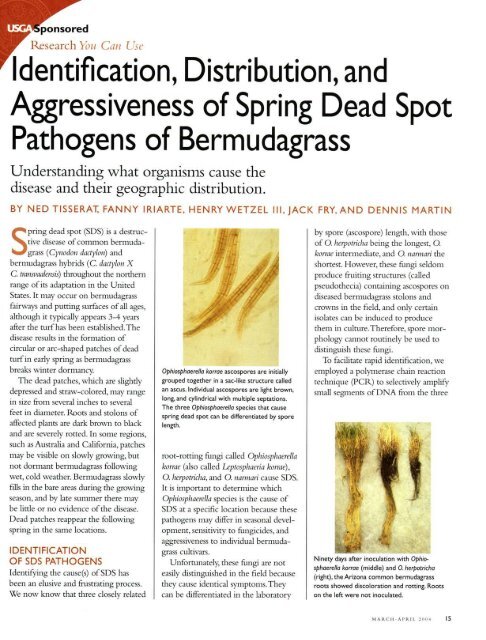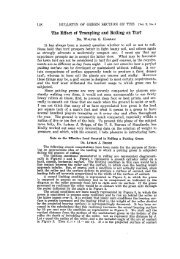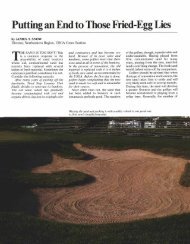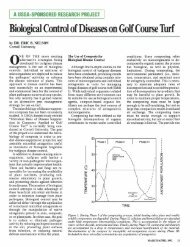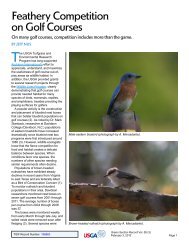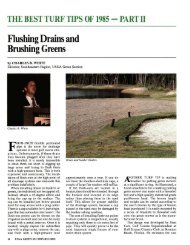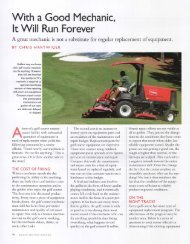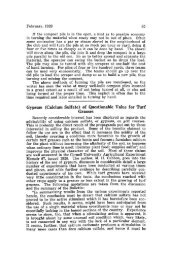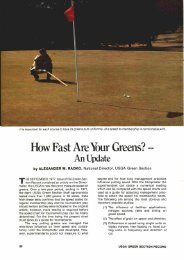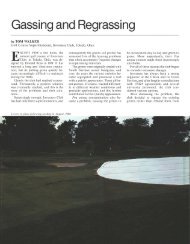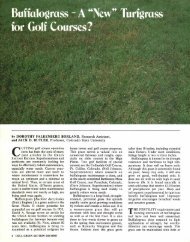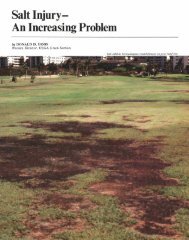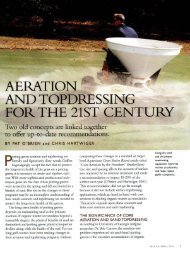Identification, Distribution, and Aggressiveness of Spring Dead Spot ...
Identification, Distribution, and Aggressiveness of Spring Dead Spot ...
Identification, Distribution, and Aggressiveness of Spring Dead Spot ...
- No tags were found...
You also want an ePaper? Increase the reach of your titles
YUMPU automatically turns print PDFs into web optimized ePapers that Google loves.
ponsoredResearch You Can else<strong>Identification</strong>, <strong>Distribution</strong>,<strong>and</strong><strong>Aggressiveness</strong> <strong>of</strong> <strong>Spring</strong> <strong>Dead</strong> <strong>Spot</strong>Pathogens <strong>of</strong> BermudagrassUnderst<strong>and</strong>ing what organisms cause thedisease <strong>and</strong> their geographic distribution.BY NED TISSERA"T, FANNY IRIARTE, HENRY WETZEL III, JACK FRY, AND DENNIS MARTIN<strong>Spring</strong> dead spot (SDS) is a destructivedisease <strong>of</strong> common bermudagrass(Cynodon dactylon) <strong>and</strong>bermudagrass hybrids (C. dactylon XC. transvaalensis) throughout the northernrange <strong>of</strong> its adaptation in the UnitedStates. It may occur on bermudagrassfairways <strong>and</strong> putting surfaces <strong>of</strong> all ages,although it typically appears 3-4 yearsafter the turf has been established. Thedisease results in the formation <strong>of</strong>circular or arc-shaped patches <strong>of</strong> deadturf in early spring as bermudagrassbreaks winter dormancy.The dead patches, which are slightlydepressed <strong>and</strong> straw-colored, may rangein size from several inches to severalfeet in diameter. Roots <strong>and</strong> stolons <strong>of</strong>affected plants are dark brown to black<strong>and</strong> are severely rotted. In some regions,such as Australia <strong>and</strong> California, patchesmay be visible on slowly growing,butnot dormant bermudagrass followingwet, cold weather. Bermudagrass slowlyfills in the bare areas during the growingseason, <strong>and</strong> by late summer there maybe little or no evidence <strong>of</strong> the disease.<strong>Dead</strong> patches reappear the followingspring in the same locations.IDENTIFICATIONOF SDS PATHOGENSIdentifying the cause(s) <strong>of</strong>SDS hasbeen an elusive <strong>and</strong> frustrating process.We now know that three closely relatedOphiosphaerella korrae ascospores are initiallygrouped together in a sac-like structure calledan ascus. Individual ascospores are light brown,long, <strong>and</strong> cylindrical with multiple septations.The three Ophiosphaerella species that causespring dead spot can be differentiated by sporelength.root-rotting fungi called Ophiosphaerellakorrae (also called Leptosphaeria korrae),O. herpotricha, <strong>and</strong> O. narmari cause SDS.It is important to determine whichOphiosphaerella species is the cause <strong>of</strong>SDS at a specific location because thesepathogens may differ in seasonal development,sensitivity to fungicides, <strong>and</strong>bermuda-aggressiveness to individualgrass cultivars.Unfortunately, these fungi are noteasily distinguished in the field becausethey cause identical symptoms. Theycan be differentiated in the laboratoryby spore (ascospore) length, with those<strong>of</strong> O. herpotricha being the longest, O.korrae intermediate, <strong>and</strong> O. narmari theshortest. However, these fungi seldomproduce fruiting structures (calledpseudothecia) containing ascospores ondiseased bermudagrass stolons <strong>and</strong>crowns in the field, <strong>and</strong> only certainisolates can be induced to producethem in culture. Therefore, spore morphologycannot routinely be used todistinguish these fungi.To facilitate rapid identification,weemployed a polymerase chain reactiontechnique (PCR) to selectively amplifysmall segments <strong>of</strong> DNA from the threeNinety days after inoculation with Ophiosphaerellakorrae (middle) <strong>and</strong> O. herpotricha(right). the Arizona common bermudagrassroots showed discoloration <strong>and</strong> rotting. Rootson the left were not inoculated.MARCH-APRIL 2004 15
Ophiosphaerella species. By using speciesspecificoligonucleotide primers, DNAcan be differentially amplified followingDNA extraction from fungal culturesor diseased tissue. For example, if a PCRreaction is run using primers specificfor o. narmari, only DNA <strong>of</strong> this fungus<strong>and</strong> not others, including other Ophiosphaerellaspecies, will be amplified.Thus, the use <strong>of</strong> PCR primers specificto the three SDS pathogens can be usedto determine which fungus is present ina diseased root. Amplified DNA can bedetected in several ways, but commonlyit is stained, loaded into an agarose gelplaced in a buffer solution, <strong>and</strong> thensubjected to an electrical current. As theamplified DNA migrates through thegel, it can be visualized using ultravioletlight.DISTRIBUTION OF SDSPATHOGENS IN THE U.S.One <strong>of</strong> our objectives was to determinethe geographic distribution <strong>of</strong> SDSpathogens. The fungus o. narmari hadpreviously been reported to be the primarycause <strong>of</strong> SDS in Australia, but ithad not been found in North America.Ophiosphaerella korrae also was reportedto be widespread in Australia <strong>and</strong> wasdocumented as the cause <strong>of</strong> SDS inMaryl<strong>and</strong> <strong>and</strong> California, whereas O.herpotricha was recovered from SDSpatches in Kansas <strong>and</strong> Oklahoma.However, these early studies providedan incomplete picture <strong>of</strong> the geographicdistribution <strong>of</strong> SDS pathogens in theUnited States because they were basedon a limited number <strong>of</strong> samples collectedfrom just a few geographic locations.Bermudagrass selections are screened for spring dead spot resistance in replicated field trialsin Stillwater, Oklahoma. Each plot was inoculated with Ophiosphaerella herpotricha, O. korrae,<strong>and</strong> 0. narmari. Several selections showed good resistance to the disease.Since 1994 we have intensivelysampled golf course fairways in severalstates <strong>and</strong> also collecteda small number<strong>of</strong> isolates from widely dispersed geographiclocations throughout much <strong>of</strong>the range <strong>of</strong> where SDS occurs in theUnited States. Our survey indicates thatthere are regional differences in thedistribution <strong>of</strong> SDS pathogens. Themajority <strong>of</strong> isolates we collected inKansas <strong>and</strong> Oklahoma were o. herpotricha.Thisconfirms that this fungus isthe primary cause <strong>of</strong> SDS in the southernGreat Plains. The fungus O. korraewas isolated less frequently in thisregion, with almost all <strong>of</strong> these isolatescollected from a single golf course fairwaynear Afton, Oklahoma. Althoughonly a few o. narmari isolates wererecovered, they represented the firstreport <strong>of</strong> this fungus in North America.Ophiosphaerella narmari has since beenfound in other regions <strong>of</strong> the UnitedStates.16 GREEN SECTION RECORD
In contrast,O. korrae was the onlySDS pathogen in samples collected atsites in Mississippi,Alabama, SouthCarolina, Tennessee, <strong>and</strong> Virginia, <strong>and</strong> itwas dominant in North Carolina.Although the number <strong>of</strong>locationssampled in each state was small, theseresults suggest that O. korrae is the mostwidely distributed SDS pathogen in thesouthern United States. Both O. herpotricha<strong>and</strong> O. korrae were collected inKentucky, with their isolation frequencydependent on the location that wassampled.The distribution <strong>of</strong> SDS pathogensin the western United States is lessclear, although both O. korrae <strong>and</strong> O.narmari have been isolated from samplescollected near Los Angeles, California.Further sampling in Arizona, Nevada,California, New Mexico, <strong>and</strong> westernTexas is needed.The uneven distribution <strong>of</strong> SDSpathogens in the United States mayreflect regional differences in nativeranges <strong>of</strong> these fungi. While O. herpotrichahas been isolated from buffalograsslawns exhibiting SDS symptoms, it hasnot been isolated from this or othernative grasses in natural prairie st<strong>and</strong>s.Therefore, we are still uncertain whetherthis fungus is native to the Great Plains.It seems unlikely that O. korrae isnative to North America since bermudagrass<strong>and</strong> Kentucky bluegrass (thefungus causes necrotic ringspot on thishost), the primary hosts for this fungus,are exotic grasses. An alternative explanationis that O. korrae was introduced<strong>and</strong> dispersed on infected bermudagrassroots <strong>and</strong> stolons. Thus, O. korrae mighthave initially infected an improvedbermudagrass cultivar adapted to aspecific geographic region <strong>and</strong> then wasdispersed via contaminated sodl sprigsacross a wide geographic area.A study by Wetzel et al. supports thishypothesis. They found that O. korraeisolates collected from several southernstates were genetically similar based onDNA fingerprinting techniques. Theseisolates differed substantially from O.korrae isolates collected from Kentuckybluegrass <strong>and</strong> bermudagrass in morenorthern regions <strong>of</strong> the United States.These northern isolates also weregenetically similar. We believe that O.korrae may have been introduced intoNorth America, with one or a fewinitial introductions occurring onbermudagrass in the southern UnitedStates <strong>and</strong> another introduction inmore northern regions on Kentuckybluegrass. Further genetic studies areneeded to confirm this hypothesis.Nevertheless, these results are strongevidence that this pathogen has beenmoved from one location to anotheron infected stolons or roots.AGGRESSIVENESSOF SDS PATHOGENSWe were also interested to see if therewere differences in SDS severity followinginoculations with O. herpotricha) O.korrae, <strong>and</strong> O. narmari. A two-year-oldst<strong>and</strong> <strong>of</strong> Midlawn bermudagrass atthe Kansas State University John PairResearch Center, Wichita, Kansas, withno previous history <strong>of</strong> SDS, was inoculatedin September 1997 with the threeSDS pathogens. All 14 sites inoculatedwith O. herpotricha developed symptomsin 1999. The patches reappeared <strong>and</strong> hadexp<strong>and</strong>ed in diameter in May 2000.In contrast, only 10 <strong>of</strong> 14 sitesinoculated with O. korrae developedsymptoms in 1999, <strong>and</strong> <strong>of</strong> those only 7appeared the following year. Patchdiameters associated with O. korrae weresignificantly smaller than those causedby O. herpotricha. Unfortunately, thisstudy did not include any O. korraeisolates from the southern region. Onlyone <strong>of</strong> the sites inoculated with O.narmari developed SDS, <strong>and</strong> the patchdiameter <strong>of</strong> this spot was small.These preliminary results indicatethere are differences in aggressiveness<strong>of</strong> SDS pathogensTable I<strong>Identification</strong> <strong>of</strong> Ophiosphaerella species isolated frombermudagrass cores collected in various states.to the bermudagrassNumber <strong>of</strong> IsolatesCollection O. O. O.Location Date herpotricha korrae narmariAlabama,Vestavia Hills 1999 0 20 0Arkansas, sites unknown 1994 0 6 0California, Los Angeles 1983,1999 0 2 4Georgia, sites unknown 1994-1996 0 3 0Kansas, 20 sites 1984-2000 55 0 IKansas, Independence 1994 71 9 0Kentucky, Mayfield 1998 2 13, 0Kentucky, Henderson 1998 14 5 IKentucky, Paducah 1998 0 17 0Mississippi, Starkville 1999 0 18 2Missouri, Dunklin County 1996 2 0 0North Carolina, 12 sites 1999-2000 0 63 INorth Carolina, Raleigh 1999-2000 12 5 0Oklahoma, Afton 1994-1996 201 38 22Oklahoma, Jenks 1994 173 0 0South Carolina, 8 sites 1999-2000 0 16 0Tennessee, Knoxville 1999 0 15 0Texas, Dallas 1996 3 0 0Virginia,Virginia Beach 1999 0 20 0Virginia, Charlottesville 1999 0 5 0Virginia, site unknown 1999 0 4 0West Virginia 1999-2000 00"MARCH-APRIL 2004 17
II' If c~, Table 2Development <strong>of</strong> spring dead spot on Midlawn bermudagrass following inoculationwith Ophiosphaerella herpotricha, O.korrae, <strong>and</strong> 0. narmari inWichita, Kansas.~1999 2000Number <strong>of</strong>Number <strong>of</strong>inoculation Patch inoculation Patchsites with area sites with areaI:.' Fungal Species dead spots X (cm 1 )Y dead spots (cm 1 )Oph;osphaerella herpotr;cha 14 374a 14 1120aOphiosphaerella korrae 10 78b 7 264bOph;osphaerella narmar; I 46c I 79cSterile oats 0 0XNumber <strong>of</strong> 14 inoculation sites for each species in which spring dead spot symptoms developed.Plots were inoculated in September 1997 with three isolates <strong>of</strong> each species <strong>and</strong> were rated inMay <strong>of</strong> 1999 <strong>and</strong> 2000.YAverage patch area for those inoculation sites in which spring dead spot symptoms developed.Patch diameters not followed by the same letter are signific<strong>and</strong>y different (P


